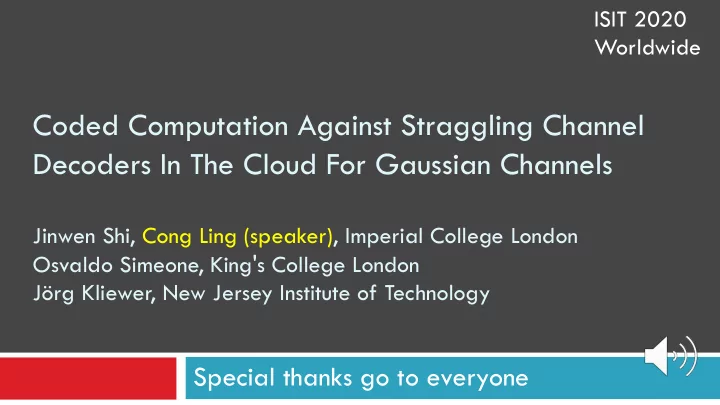

ISIT 2020 Worldwide Coded Computation Against Straggling Channel Decoders In The Cloud For Gaussian Channels Jinwen Shi, Cong Ling (speaker), Imperial College London Osvaldo Simeone, King's College London Jörg Kliewer, New Jersey Institute of Technology Special thanks go to everyone
Background 2 ¨ M. Aliasgari, J. Kliewer and O. ¨ Imperial College group Simeone, “Coded computation worked on lattice codes. against processing delays for virtualized cloud-based channel ¨ Natural to extend to decoding,” 2017 (T-COM 2019). Gaussian channels. Considered binary-symmetric channels (BSC) and binary codes. • Paper submitted to a conference in 2018 but for no reasons (i.e., no review). • Accepted by ISIT 2020!
RRH: remote radio head System model (uplink) NFV: network function virtualization 3 BSC channel, (Aliasgari, Kliewer, Simeone’17) • Cloud radio access network (C-RAN) with distributed decoding. • To handle straggling processors, Cloud re-encodes received packets.
Motivation 4 q Trivial extension? q Not really. q BSC: no “combining gain” from binary codes. q Gaussian channel: can we exploit “combining gain” by lattice codes?
Modified compute-and-forward on the cloud 5 ¨ Compute-and-forward ¨ Our work: (Nazer, Gastpar’11): packets artificially packets naturally combined by the cloud combined by the channel • Difference: accumulated noise • Also makes noise terms correlated at different servers
Encoding 6 ¨ (Single) User ¨ Cloud ¤ file is divided into K ¤ network function blocks; virtualization (NFV) k is encoder re-encodes K ¤ each block Î F p packets into N blocks, using encoded using a lattice an (N,K) linear code with code of length n and rate generator matrix G c R; ¤ N servers with random ¤ blocks received by remote delays radio heads (RRH)
Two types of codes 7 ¨ Lattice code ¨ NFV code ¤ User ¤ Cloud ¤ Channel coding ¤ Packet error/erasure correction code ¤ Assuming capacity- achieving nested lattice ¤ Deal with straggling codes (Erez-Zamir’05) processors
Lattice decoding 8 ¨ Re-encoded packets ¨ Server i gets block ¨ and aims to decode a linear equation using lattice decoding
Computation rate 9 ¨ Main Theorem: Transmission rate that allows reliable decoding of a given equation ¨ Rate penalty = (column norm) due to noise accumulation. ¨ (Non-binary) NFV codes with binary/sparse generator matrices appear to be better.
Error probability 10 ¨ Under ML lattice decoding is the Poltyrev random coding exponent ¤ where D is the gap to computational rate ¤ ¨ Plugged into (Aliasgari, Kliewer, Simeone’17) to obtain bounds on packet/frame error probability (FER)
Numerical results 11 ¨ Firstly, no NFV coding, only parallel processing ¨ LDB: large deviation bound ¨ UB: Union bound
Numerical results 12 ¤ Then, comparison of different encoding schemes ¤ NFV code (d min = 3)
Concluding remarks 13 ¨ Have we achieved our ¨ Simulation with goal set initially against practical lattice codes. BSCs? ¨ From a single-user ¨ Have to tolerate some rate loss to cope with model to multi-user straggling decoders. uplink model. ¨ Need NFV codes with sparse/binary generator matrices and good error correction.
14 Thanks for your attention! Support from EPSRC, ERC and NSF is acknowledged Email: cling@ic.ac.uk
Recommend
More recommend